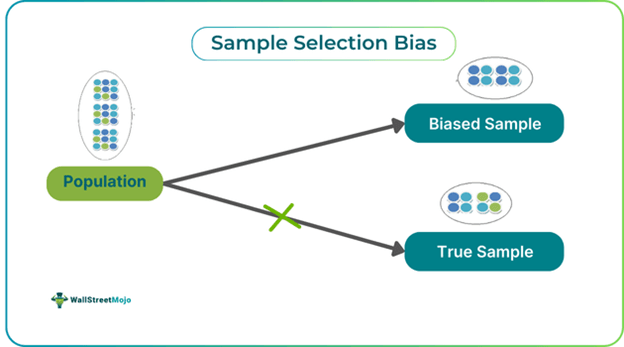Table of Contents
What Is Sample Selection Bias?
Sample selection bias arises when the sample participants do not represent the target population fairly, as some sample units are omitted. Any stage of the sampling procedure can result in sampling bias. The unequal representation of the population can mislead the study’s conclusions.

Sample collection errors may or may not be intentional, and while sampling bias cannot be completely eliminated, it can be minimized. When the sample does not accurately represent the target population, the study's findings may not generalize to the broader population. This can prevent finding effective solutions and lead to inefficient use of resources.
Key Takeaways
- Sample selection bias refers to experimental errors that result in an unrepresentative sample for a study. It occurs when the collected data does not accurately reflect the target population.
- There are two primary causes of sample selection bias: participants may self-select into the study, or bias may result from the actions of the researcher.
- Types of sample bias include self-selection bias, survivorship bias, attrition bias, ascertainment bias, non-response bias, and undercoverage bias.
- This type of bias can be minimized by taking careful measures during all stages of the research process, including the design, sampling, and evaluation stages.
Sample Selection Bias Explained
Sample selection bias refers to experimental errors that result in an unrepresentative sample for a study. It occurs when the collected data does not accurately reflect the intended population. There are two primary causes of sample selection bias: First, participants may self-select into the study. Second, biases may result from the researcher’s actions. Additionally, bias can arise when subgroup characteristics are overlooked. This leads to fundamental differences between the variables in the sample data and the research population.
Selection bias is a type of systematic error. Systematic differences between treatment and control groups, or between participants and non-participants, make it harder to compare groups and draw objective conclusions. Selection bias frequently occurs in observational studies such as case-control, cohort, and cross-sectional studies where sample selection is not random.
There are several potential sources of selection bias that can affect a study, either in terms of participant recruitment or retention. These include flawed inclusion and exclusion criteria used during the participant selection process. In many cases, there is no clear reason why some individuals participate while others do not or why certain samples are selected over others.
Types
Types of sample selection bias include the following:
- Self-selection bias: Self-selection bias, also known as volunteer bias, occurs when participants fully decide whether or not they wish to engage in the study. This leads to a sample that may not represent the target population accurately.
- Survivorship bias: Survivorship bias occurs when researchers focus primarily on the successes or "survivors" within a group, leading to conclusions that overlook failures or those who did not "survive" the process.
- Attrition bias: Attrition bias happens when participants drop out of a study before it is completed. This can lead to incomplete data and reduce the validity of the study’s conclusions due to the unknown effects of those who left the study.
- Ascertainment bias: Ascertainment bias, also known as sampling bias, occurs when certain members of the target population are less likely to be included in the sample. This results in the sample being unrepresentative of the population.
- Non-response bias: Non-response bias arises when individuals who do not respond to a survey differ significantly from those who do respond. This can occur when non-respondents are either unable or unwilling to participate, skewing the results.
- Undercoverage bias: Undercoverage bias occurs when a subset of the population is underrepresented in the sample. This is common in convenience sampling, where researchers select participants who are easy to access, leading to a biased sample.
Examples
Let us look into a few examples:
Example #1
Suppose the government of the country "XYZ" decided to experiment with policy-making. They created a financial policy document and shared it on social media to gather public feedback, aiming to revise the policy based on input from both the general public and experts. While the feedback was overwhelmingly positive, the policy did not achieve the expected success after implementation. This happened because most of the responses came from the general public, many of whom lacked sound financial expertise. The results would likely have been different if more experts had participated in the feedback process.
Example #2
Imagine a news agency reporting on the "aftereffects of war." The agency interviewed veterans who survived the war to gather their experiences. However, by focusing only on survivors, the agency neglects the experiences of families who lost loved ones in the war. These families also endure the aftereffects of war, yet they are excluded from the study.
How To Avoid?
Sampling bias can be minimized by taking careful measures at every stage of the research process. The first step is developing a solid survey design. Clearly defining the objective of the survey and setting standards for fair representation is key to building a strong foundation.
Steps to prevent bias during the sampling process include proper randomization. Researchers should ensure the sample is current and accurately represents the target population. They should also ensure that all relevant subgroups are included and appropriately studied so no important segments are left out.
During the evaluation stage, it is essential to ensure the process remains free from bias. Conducting a second review is always advisable. Utilizing technology to track changes and monitor data accurately can also help avoid errors. Regularly checking progress and identifying deviations assists in detecting and correcting potential biases.
